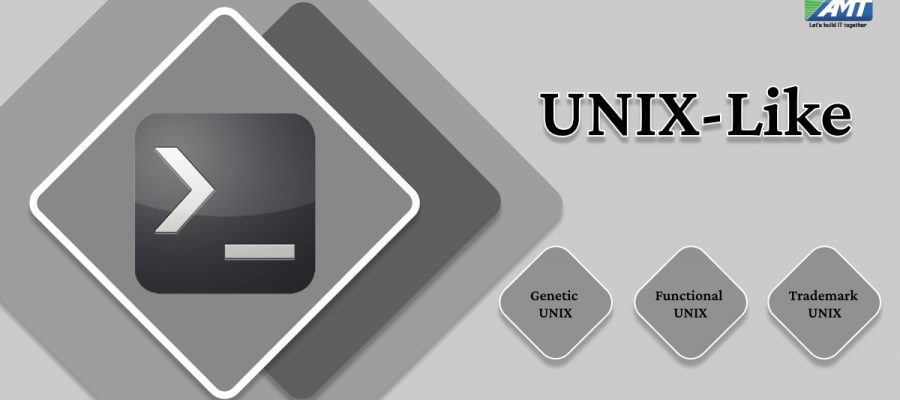A Unix-like (sometimes referred to as UN*X or *nix) operating system is one that behaves in a manner similar to a Unix system, while not necessarily conforming to or being certified to any version of the Single UNIX Specification. A Unix-like application is one that behaves like the corresponding Unix command or shell. There is no standard for defining the term, and some difference of opinion is possible as to the degree to which a given operating system or application is “Unix-like”
The term can include free and open-source operating systems inspired by Bell Labs’ Unix or designed to emulate its features, commercial and proprietary work-alikes, and even versions based on the licensed UNIX source code (which may be sufficiently “Unix-like” to pass certification and bear the “UNIX” trademark).
The Open Group owns the UNIX trademark and administers the Single UNIX Specification, with the “UNIX” name being used as a certification mark. They do not approve of the construction “Unix-like”, and consider it a misuse of their trademark. Their guidelines require “UNIX” to be presented in uppercase or otherwise distinguished from the surrounding text, strongly encourage using it as a branding adjective for a generic word such as “system”, and discourage its use in hyphenated phrases.
Other parties frequently treat “Unix” as a genericized trademark. Some add a wildcard character to the name to make an abbreviation like “Un*x” or “*nix”, since Unix-like systems often have Unix-like names such as AIX, A/UX, HP-UX, IRIX, Linux, Minix, Ultrix, Xenix, Xinu, and XNU. These patterns do not literally match many system names, but are still generally recognized to refer to any UNIX system, descendant, or work-alike, even those with completely dissimilar names such as Darwin/macOS, illumos/Solaris or FreeBSD.
In 2007, Wayne R. Gray sued to dispute the status of UNIX as a trademark, but lost his case, and lost again on appeal, with the court upholding the trademark and its ownership.
Dennis Ritchie, one of the original creators of Unix, expressed his opinion that Unix-like systems such as Linux are de facto Unix systems. Eric S. Raymond and Rob Landley have suggested that there are three kinds of Unix-like systems:
Genetic UNIX:
Those systems with a historical connection to the AT&T codebase. Most commercial UNIX systems fall into this category. So do the BSD systems, which are descendants of work done at the University of California, Berkeley in the late 1970s and early 1980s. Some of these systems have no original AT&T code but can still trace their ancestry to AT&T designs.
Trademark or branded UNIX:
These systems—largely commercial in nature—have been determined by the Open Group to meet the Single UNIX Specification and are allowed to carry the UNIX name. Most such systems are commercial derivatives of the System V code base in one form or another, although Apple macOS 10.5 and later is a BSD variant that has been certified, EulerOS and Inspur K-UX are Linux distributions that have been certified, and a few other systems (such as IBM z/OS) earned the trademark through a POSIX compatibility layer and are not otherwise inherently Unix systems. Many ancient UNIX systems no longer meet this definition.
Functional UNIX:
Broadly, any Unix-like system that behaves in a manner roughly consistent with the UNIX specification, including having a “program which manages your login and command line sessions”; more specifically, this can refer to systems such as Linux or Minix that behave similarly to a UNIX system but have no genetic or trademark connection to the AT&T code base. Most free/open-source implementations of the UNIX design, whether genetic UNIX or not, fall into the restricted definition of this third category due to the expense of obtaining Open Group certification, which costs thousands of dollars[citation needed] for commercial closed source systems.
Around 2001, Linux was given the opportunity to get a certification including free help from the POSIX chair Andrew Josey for the symbolic price of one dollar. There have been some activities to make Linux POSIX-compliant, with Josey having prepared a list of differences between the POSIX standard and the Linux Standard Base specification, but in August 2005, this project was shut down because of missing interest at the LSB work group.
Some non-Unix-like operating systems provide a Unix-like compatibility layer, with varying degrees of Unix-like functionality.
- IBM z/OS’s UNIX System Services is sufficiently complete as to be certified as trademark UNIX.
- Cygwin and MSYS both provide a GNU environment on top of the Microsoft Windows user API, sufficient for most common open source software to be compiled and run.
- The MKS Toolkit and UWIN are comprehensive interoperability tools which allow the porting of Unix programs to Windows.
- Windows NT-type systems have a POSIX environmental subsystem.
- Subsystem for Unix-based Applications (previously Interix) provides Unix-like functionality as a Windows NT subsystem (discontinued).
- Windows Subsystem for Linux provides a Linux-compatible kernel interface developed by Microsoft and containing no Linux code, with Ubuntu user-mode binaries running on top of it.
Other means of Windows-Unix interoperability include:
- The above Windows packages can be used with various X servers for Windows
- Hummingbird Connectivity provides several ways for Windows machines to connect to Unix and Linux machines, from terminal emulators to X clients and servers, and others
- The Windows Resource Kits for versions of Windows NT include a Bourne Shell, some command-line tools, and a version of Perl
- Hamilton C shell is a version of csh written specifically for Windows.
The above is a brief about Unix-like. Watch this space for more updates on the latest trends in Technology.
